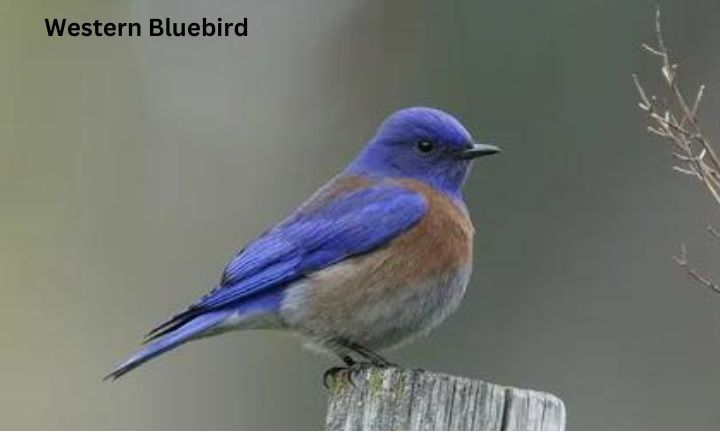California has a vibrant array of bird species, but few captivate the eye and soul like the bluebirds that grace its skies. As a nature enthusiast living in California, my heart always skips when I glimpse the vibrant blue plumage of these magnificent creatures – the bluebirds in California.
we will delve into the world of bluebirds in California and spotlight two distinct species that call this diverse region home. From their mesmerizing plumage to their enchanting songs, these avian wonders embody the essence of tranquillity and grace in the wild. Join me on this journey as we explore the fascinating world of bluebirds in California, uncovering their secrets and celebrating their presence in our midst.
Mountain Bluebird

Identification
The Mountain Bluebird, known for its stunning sky-blue plumage, is a delightful sight to behold in California’s vast wilderness. These graceful birds can be easily identified by their vibrant colouration and slim build, making them stand out against the rugged mountain landscapes they call home.
Bluebirds in California are visually striking and play important ecological roles in their habitats. One key feature distinguishing the Mountain Bluebird from other bluebirds in California is its distinctive call, a soft warble that echoes through the crisp mountain air. This melodic song is a beacon for birdwatchers drawn to these elusive creatures like moths to a flame. Read and get info All About Owl Legs. Owl legs, often overshadowed by their majestic wings and captivating facial structure.
Observing their graceful flight patterns and intricate aerial acrobatics is a true testament to nature’s artistry, offering a profound sense of connection to the wild landscapes that these majestic birds inhabit.
Range
The Vibrant Mountain Bluebird, known for its brilliant azure hue, can be spotted throughout the western United States, including California. These striking birds often inhabit open woodlands, sagebrush fields, and mountain meadows, adding colour to the landscape.
While their range extends much further into Canada and Mexico, they truly showcase their beauty in the picturesque mountains and valleys of California. In California, these bluebirds can dart through the clear skies or perched on fence posts along country roads.
Diet and Foraging Habits
The Mountain Bluebird, commonly found in California, primarily eats insects such as beetles, grasshoppers, ants, and caterpillars. However, during the winter months, when insects are scarce, they also feed on berries and fruits.
These bluebirds are known for their swift and agile movements while hunting for food. They use their sharp eyesight to locate small insects among grassy areas or perched on branches. An important aspect of their diet is the need for high-quality protein-rich foods to support their active lifestyles and energetic flights across vast mountainous regions in California.
Where to Find This Bird
Mountain Bluebirds are a breathtaking sight for birdwatchers in California, with their vibrant blue feathers contrasting against the backdrop of the rugged mountains. Head to higher elevations in the Sierra Nevada or Cascade mountain ranges to catch a glimpse of these stunning creatures.
One of the best places to spot Mountain Bluebirds in California is Lassen Volcanic National Park. The park’s diverse landscape provides the perfect habitat for these birds, offering plenty of opportunities for observation and photography
Western Bluebird

Identification
The Western Bluebird is a stunning species of bluebird native to California, known for its vibrant blue plumage and distinct orange throat and breast.
One way to easily identify these beautiful birds is by their size, slightly smaller than a robin with a plump, rounded shape.Discover Stunning Black Birds in Florida, very beautiful bird in Florida.
Their colouration stands out against the backdrop of the lush greenery in the Californian landscape, making them a joy to spot in wooded areas or perched on fences and branches. While bluebirds are quite common in California, the Western Bluebird can be differentiated from its Eastern counterpart by its paler blue hue and warmer colour palette.
Range
The Western Bluebird, commonly found in western North America, including California, is a stunning sight to behold. These birds bring colour and joy to their surroundings with vibrant blue plumage and a cheerful call. Spotting a flock of bluebirds in California can be an enchanting experience that connects us to nature’s beauty. Western bluebirds are known for their preference for nesting in cavities within trees or artificial structures such as nest boxes. They have also been observed in various parts of Oregon.
Diet and Foraging Habits
They are voracious insect-eaters, feeding on beetles, caterpillars, grasshoppers, and other small invertebrates. However, they supplement their diet with fruit-like berries when insects are scarce. This dietary flexibility allows them to thrive in various habitats throughout the western United States.
In terms of foraging habits, Western Bluebirds employ several techniques to capture their prey. They often perch on low branches or wires and scan the ground for movement before swooping to catch their unsuspecting prey. They are skilled at gleaning insects from foliage and using their sharp beaks to extract larvae from tree crevices.
Where to Find This Bird
Some of the best places to find Western Bluebirds include local parks, vineyards, and gardens that offer a mix of open spaces and trees for nesting. there are several prime locations worth exploring. Places like Joshua Tree National Park and Yosemite National Park offer great opportunities to spot Western Bluebirds amidst the picturesque landscapes of the Golden State.
Summary
bluebirds in California are a fascinating and important part of the state’s ecosystem. By learning about the Western Bluebird and the Mountain Bluebird, we can appreciate their unique characteristics and contribute to their conservation efforts. These iconic species bring beauty and joy to our surroundings, reminding us of the importance of preserving natural habitats. As we continue to study and protect these bluebirds, we ensure that future generations will also be privileged to witness their grace and charm in the wild. Let’s work together to safeguard these beautiful birds for years to come.


